|
86. Hipparchia semele (Linnaeus, 1758) / Grayling / Nymphalidae – Satyrinae
NL: heidevlinder, heivlinder / D: Rostbinde, Ockerbindiger Samtfalter / F: agreste
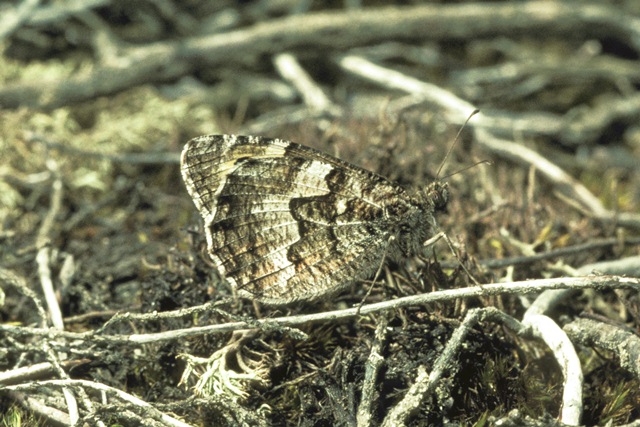 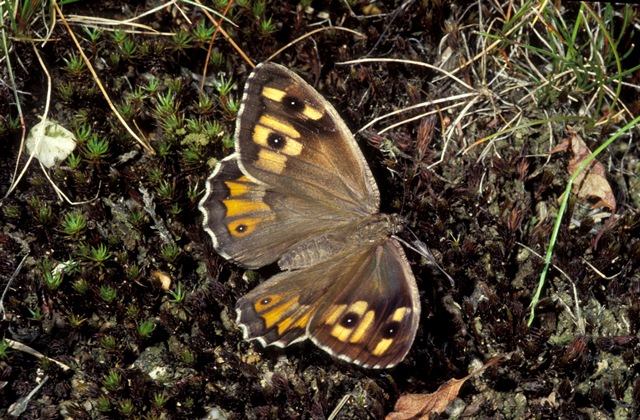 
Photographs: Frits Bink, Frits Bink, Jeroen Voogd ©.
Medium-sized or large, wing length 26 (22-28) mm. Occurs in all countries of the Benelux locally in dunes, heathland, inland drift sand, chalk grassland. In all cases the requirement is for short vegetation with patches of bare soil.
Butterfly is on the wing from mid-July until mid-September and peaks early-August.
The species is known from maritime and mild continental climates, amplitude 4 to 14. Required heat sum 500°d and maximum tolerated 3000°d, corresponding climate windows 21 weeks and the entire year open.
The species occurs in Ireland, United Kingdom and Scandinavia predominantly in the coastal zone, the sunniest sites. In Mediterranean climate, as in Spain, it prefers a woodland environment where it can also aestivate during the hot and dry summer.
In the Benelux, this phenomenon can be observed; the butterflies will fly from open fields into woodland when the summer is too hot and dry to stay in the open field.
Ecological characteristics
Behaviour over time
Overwintering: larva in second or third instar, hidden in a tussock of its host-plant.
Reproduction: oviposition starts after 16 (14-18) days when the body contains 110 (90-126) eggs, estimated production 2.1 times as much. Female produces 30-35 eggs per day.
Larval feeding periods: late summer about 36 days from mid-September until early-November, in the next spring 74 (65-83) days from mid-March until mid-June.
Generations: one.
Spreading of risk: variation in lifecycle by aestivating to adjust to local weather conditions.
Life cycle: egg 18 (15-23) days; larva 38-43 weeks; pupa 34 (30-36) days.
Life span of adult: very long, more than 6 weeks.
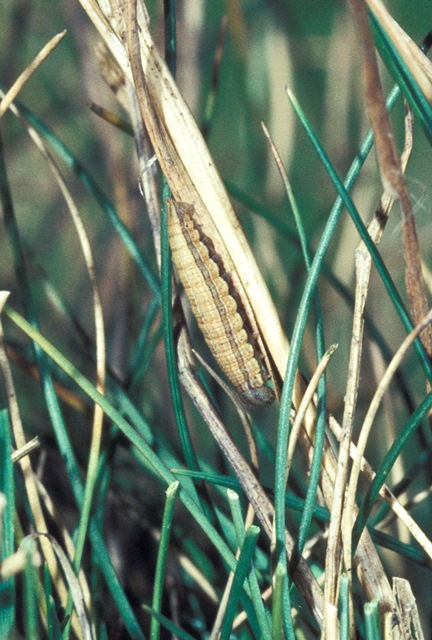 
Photographs: Frits Bink ©.
Behaviour in space
From stay-at-home to migrant: stay-at-home, spatial requirement modest.
Finding a mate: male perches and performs an exuberant courtship.
Orientation in the landscape: in temperate climate open field with short vegetation and bare soil but in warmer climates edges of woodland.
Oviposition: on wilted stems of small tussocks.
Defence
Threats from other organisms: avoidance by hiding and cryptic colours.
Threats from the environment: tolerates heat and drought well.
Feeding habits
Adult: nectar and juice, all kinds of flowers, rotten fruit and sap of wounded trees.
Larva: in summer nocturnal. Pupating in a self-made chamber in the soil.
Larval foodplants
Plant species: Poaceae, e.g. Agrostis vinealis, Brachypodium pinnatum, Corynephorus canescens, Festuca ovina, F. rubra.
Journal
Rearing experiment based on specimen from national park Hoge Veluwe, Netherlands:
30 August 1985: female captured.
4 September: 29 eggs laid.
19 September: first eggs hatched.
11 October: larvae mid first stage.
16 October: biggest larva in moult L1-2, smallest one still fresh. Spread in larval development in first stage.
25 October: larvae in second instar, basked in sunshine.
11 December: larvae end second instar, in daytime sat at the top of grass stems.
Overwintered outdoors.
8 March 1986: pot with tussock taken indoors.
9 March: some activity, the gut of a few larvae were empty.
15 March: first larva in moult L2-3.
4 April: all larvae equal in size, mid fourth instar.
26 April: all larvae mid fifth instar.
10 May: fully grown larvae 32 mm in length, when disturbed contracted to 24 mm.
17 May: 3 prepupae, 7 larvae active.
21 May: two larvae pupated, nearly all others ready to pupate, only three larvae still feeding.
31 May: three pupae dug up.
9 June: last larva pupated.
19 June: first adult appeared, male.
23 June: first female appeared.
28 June: last pupa hatched.
16 July: female hatched 25 June started to oviposit and laid 5 eggs after a pre-oviposition period of 21 days.
Table 86-1. Results of dissections

Table 86-1a. Sequential dissections of females from Hoge Veluwe in 1984
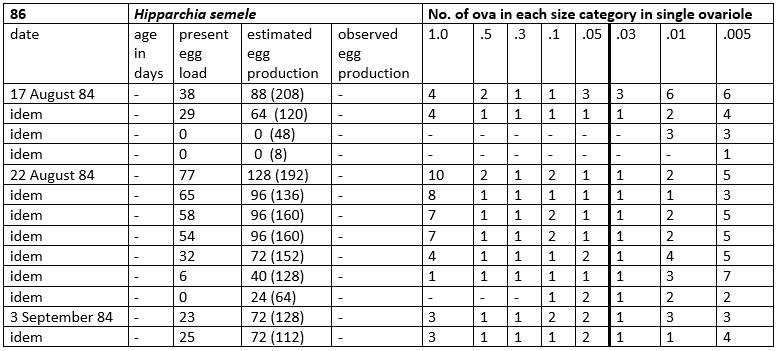
Additional figures: Weights eggs (6 September 1985) 0,235 mg, weight pupae (3 June 1985) 344 ± 19 mg (n=29).
Table 86-2. Collection and observation localities
D, Kaiserstuhl, Badberg, 433 m, 48° 05’ 47”N – 7° 40’ 40”E; 9 July 1985.
F, Aurel, 400 m, 44° 43’N – 5° 16’E; 29 August 1984.
F, Brittany, Telgruc-sur- Mer 48° 12’ 25”N – 4° 22’ 25”W; 29 September 2004.
F, Normandy, Havre de Surville 49° 16’ 47”N – 1° 40’ 23”W; 19 September 2005.
F, Vosges, Bollenberg, 363 m, 47° 56’ 54”N – 7° 15’21”E; 25 July 1983, 11 June 1984.
NL, Hoge Veluwe 52° 05’N – 5° 51’E; 11 July 1983, 30 July 1984, 30 August 1985, 31 August 2000.
NL, Hoge Veluwe, 40 m, 52° 04’ 40”N – 5° 49’ 21”E; 27 July 2000.
NL, Kootwijkerzand, 25 m, 52° 10’ 10”N – 5° 46’ 22”E; 28 August 2011.
NL, Maarheeze, Cranendonck 51° 17’ 58”N – 5° 32’ 26”E; 27 August 1981.
S, Gotland, Grodde 57° 52’ 01”N – 18° 49’ 02”E; 2 July 2004.
S, Gotland, Klinteklinten 57° 40’ 14”N – 18° 46’ 26”E; 13 July 2004.
S, Gotland, Östergarn 57° 24’ 43”N – 18° 43’ 27“E; 15 July 2004.
S, Öland, Eketorp borg 56° 17’ 43”N – 16° 29’ 10”E; 23 July 2004.
Fig. 86-1. Hipparchia semele, phenogram adapted from Bos et al. 2006: 237.

Fig. 86-2. Hipparchia semele, habitat characteristics.
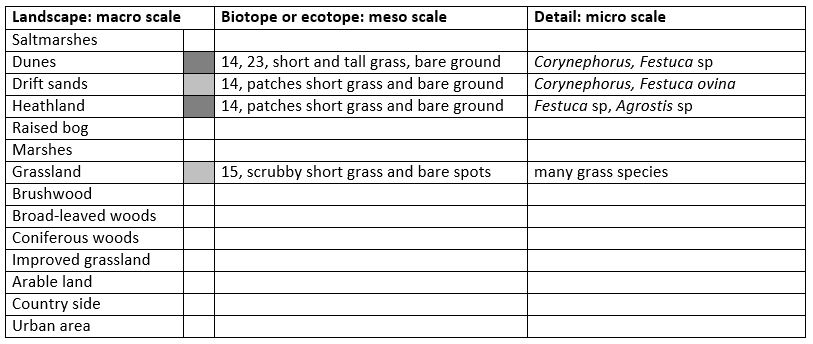
Fig. 86-3. Hipparchia semele, climate matrix, heat-sums 500 - 3000°d.
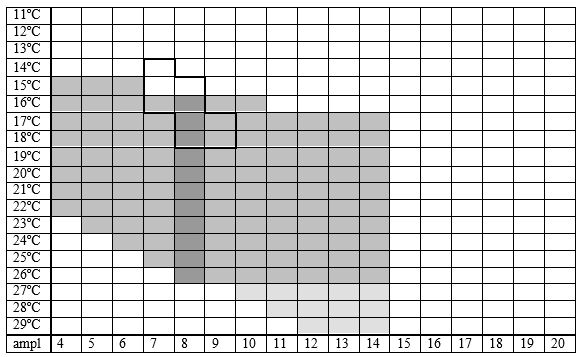
|











